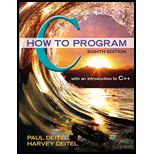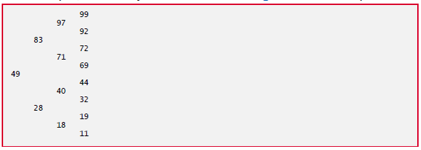
Concept explainers
(Printing Trees) Write a recursive function outputTree to display a binary tree on the screen. The function should output the tree row-by-row with the top of the tree at the left of the screen and the bottom of the tree toward the right of the screen. Each row is output vertically. For example, the binary tree illustrated in Fig12.22. is output as follows:

Note that the rightmost leaf node appears at the top of the output in the rightmost column, and the root node appears at the left of the output. Each column of output starts five spaces to the right of the previous column. Function outputTree should receive as arguments a pointer to the root node of the tree and an integer totalSpaces representing the number of spaces preceding the value to be output (this variable should start at zero so that the root node is output at the left of the screen). The function uses a modified inorder traversal to output the tree. The
While the pointer to the current node is not NULL.
Recursively call outputTree with the current node’s right subtree and totalSpaces + 5.
Use a for statement to count from 1to totalSpaces Output the value in the current node.
Recursively call outputTree with the current nodes left subtree and totalSpaces + 5.
Want to see the full answer?
Check out a sample textbook solution
Chapter 12 Solutions
C How To Program Plus Mylab Programming With Pearson Etext -- Access Card Package (8th Edition)
Additional Engineering Textbook Solutions
Modern Database Management
Degarmo's Materials And Processes In Manufacturing
SURVEY OF OPERATING SYSTEMS
Management Information Systems: Managing The Digital Firm (16th Edition)
Starting Out with Python (4th Edition)
Java How to Program, Early Objects (11th Edition) (Deitel: How to Program)
 C++ Programming: From Problem Analysis to Program...Computer ScienceISBN:9781337102087Author:D. S. MalikPublisher:Cengage LearningProgramming Logic & Design ComprehensiveComputer ScienceISBN:9781337669405Author:FARRELLPublisher:Cengage
C++ Programming: From Problem Analysis to Program...Computer ScienceISBN:9781337102087Author:D. S. MalikPublisher:Cengage LearningProgramming Logic & Design ComprehensiveComputer ScienceISBN:9781337669405Author:FARRELLPublisher:Cengage C++ for Engineers and ScientistsComputer ScienceISBN:9781133187844Author:Bronson, Gary J.Publisher:Course Technology Ptr
C++ for Engineers and ScientistsComputer ScienceISBN:9781133187844Author:Bronson, Gary J.Publisher:Course Technology Ptr- COMPREHENSIVE MICROSOFT OFFICE 365 EXCEComputer ScienceISBN:9780357392676Author:FREUND, StevenPublisher:CENGAGE L
 Systems ArchitectureComputer ScienceISBN:9781305080195Author:Stephen D. BurdPublisher:Cengage Learning
Systems ArchitectureComputer ScienceISBN:9781305080195Author:Stephen D. BurdPublisher:Cengage Learning




